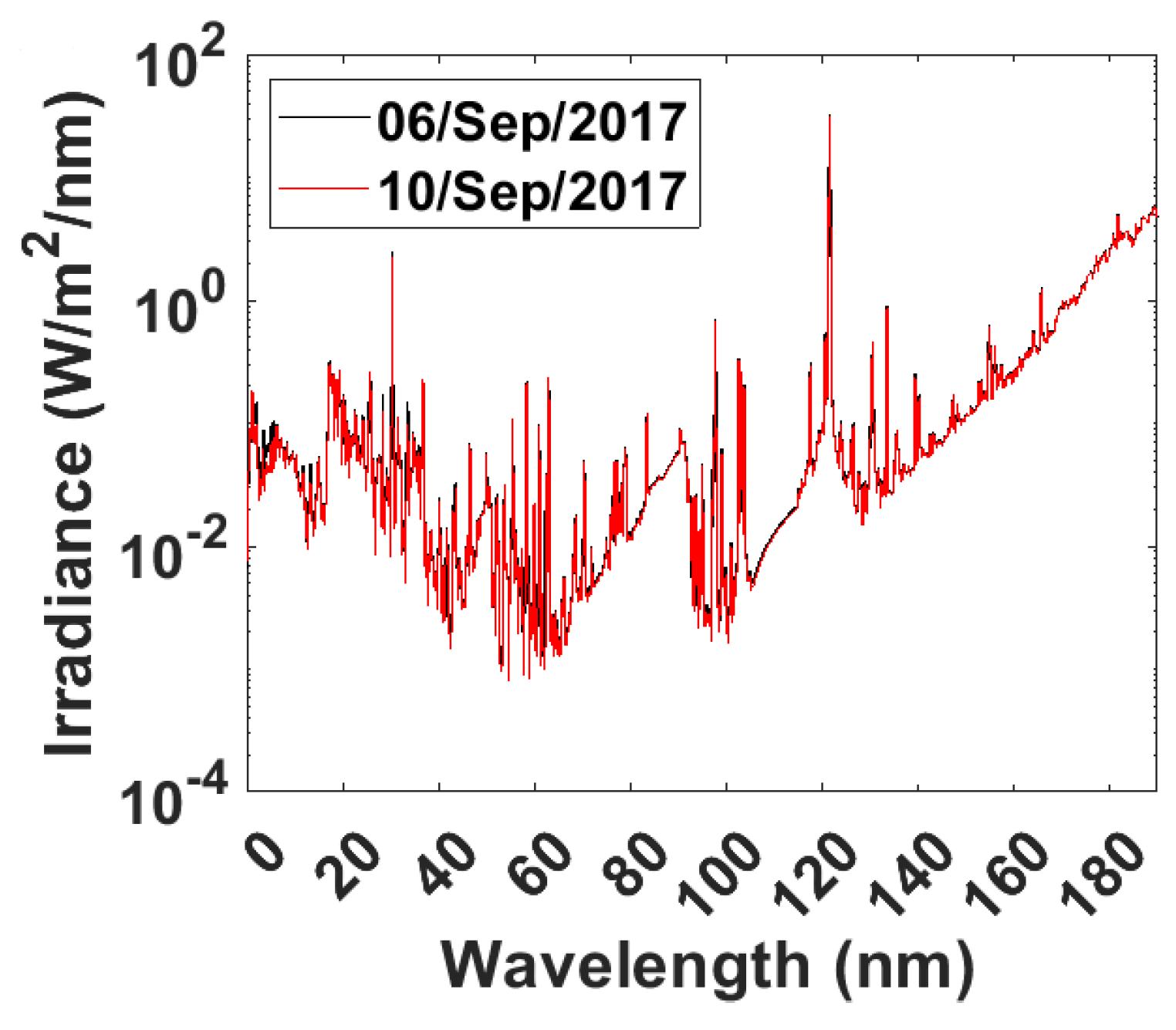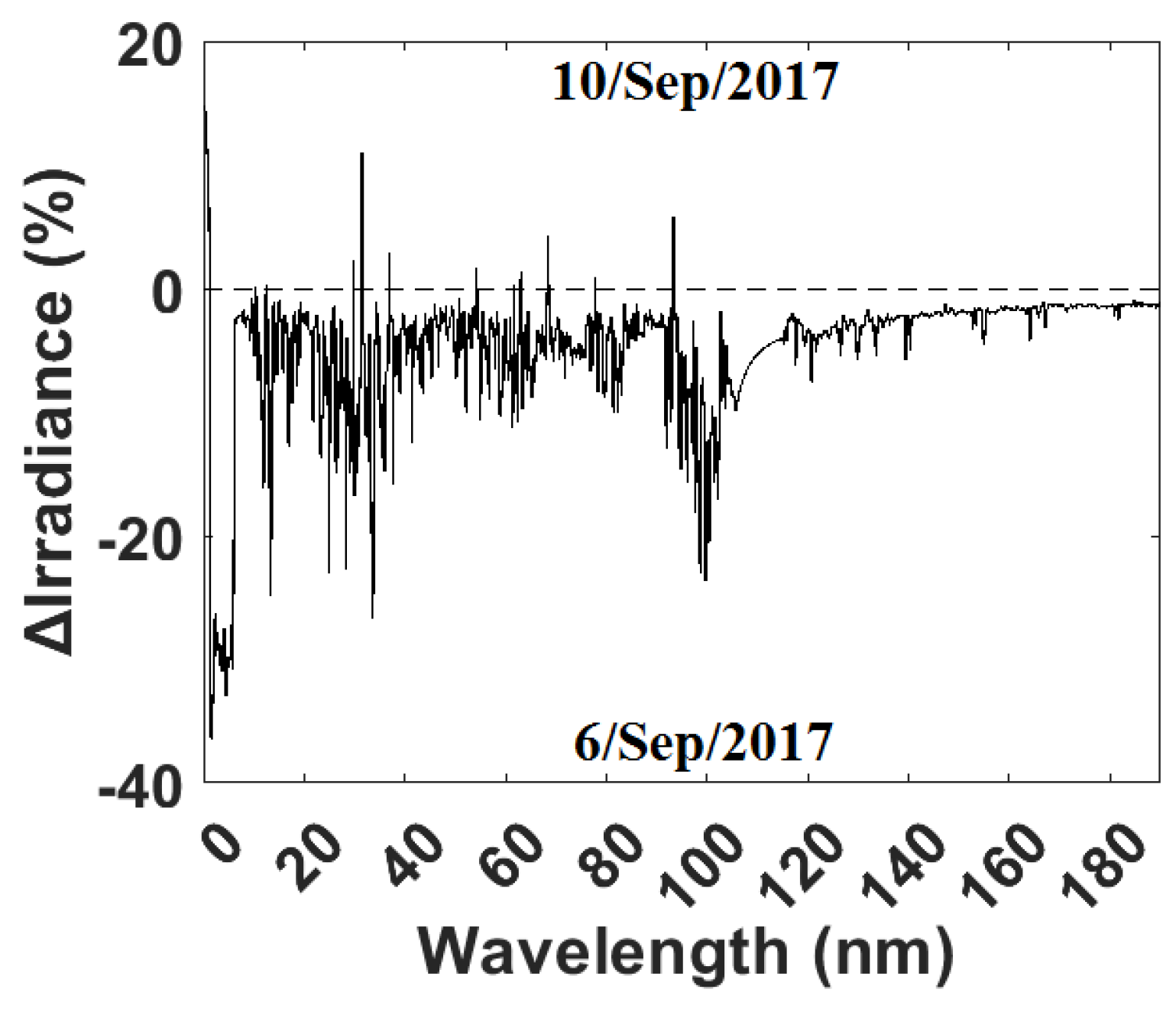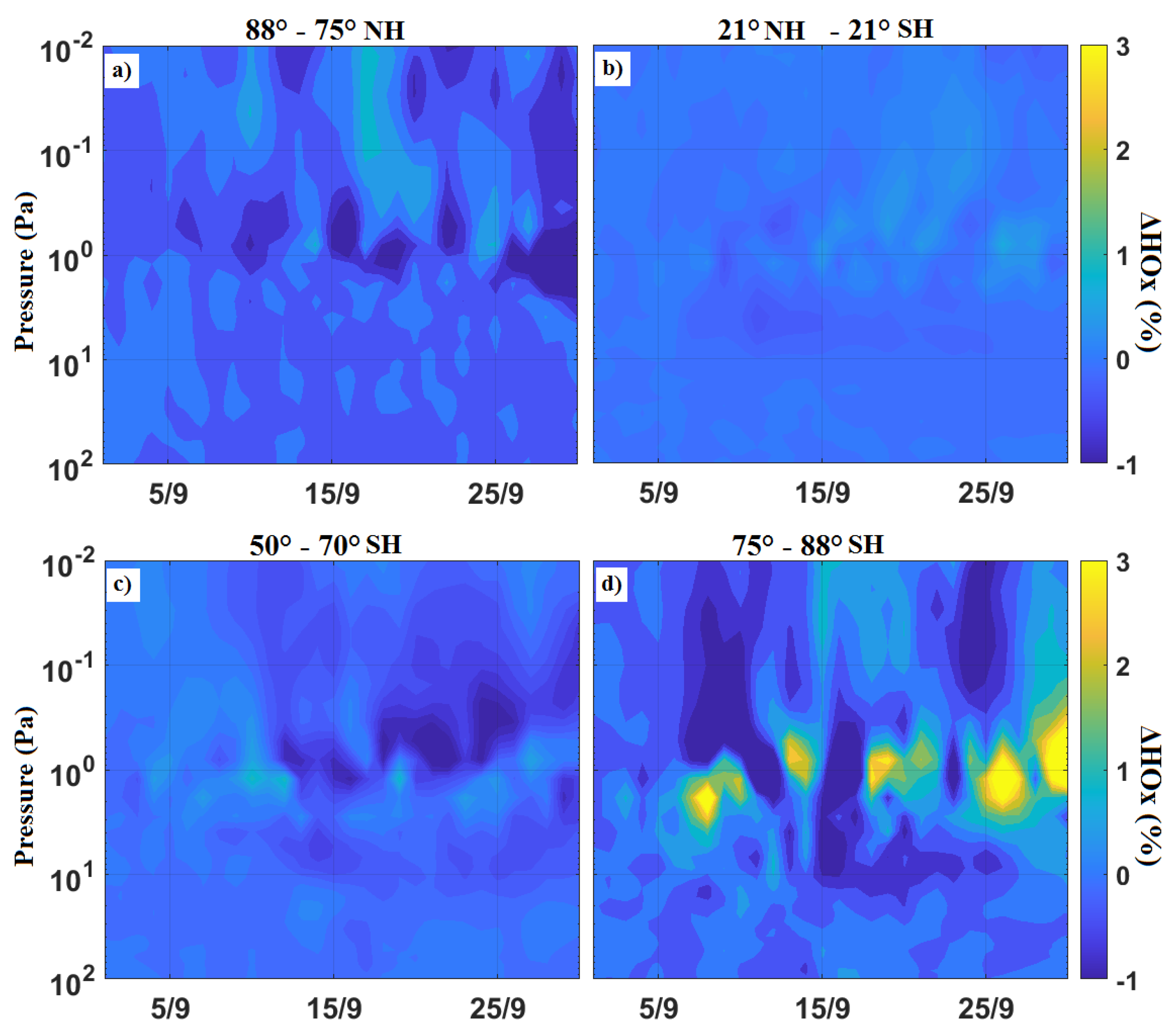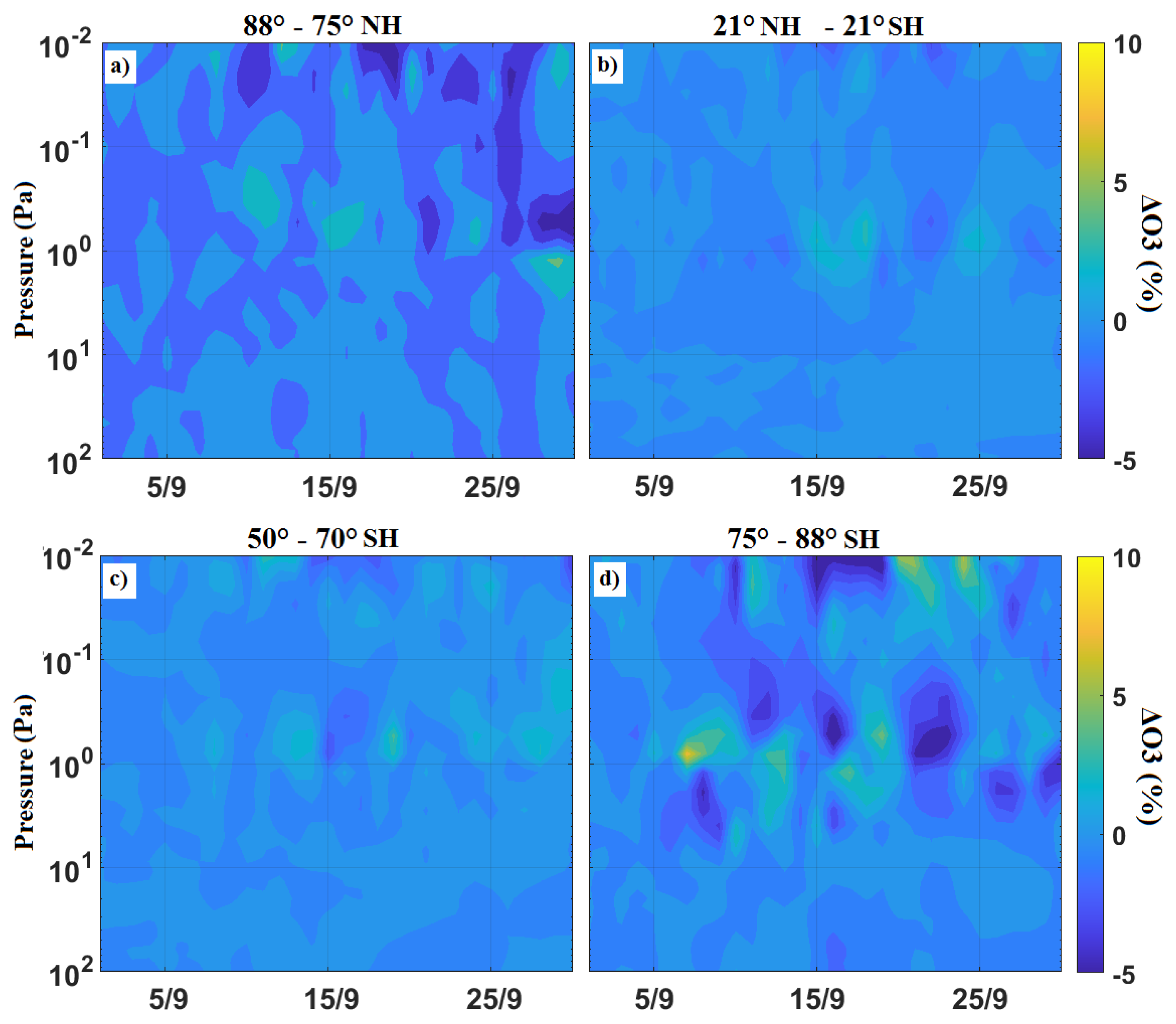1. Introduction
The ozone layer protects Earth’s biosphere by blocking solar ultraviolet (UV-B) radiation. The heating of the stratosphere by ozone defines the temperature profile behavior and facilitates the appearance of the stably stratified layer located approximately between 10 and 50 km altitudes and coined stratosphere. Ozone is an important greenhouse gas with a potential to affect the climate of the Earth. Therefore, knowledge of the climatology and evolution of the ozone layer is necessary.
Stratospheric ozone depletion has been discussed in the literature since the 1970s, but it became one of the central geophysical and societal problems after the discovery of the ozone “hole” in 1985 [
1]. Active research programs were initiated and provided explanations of the physical and chemical mechanisms behind observed negative tendencies of the stratospheric ozone evolution. The main conclusions on the anthropogenic component of this process led to the Montreal Protocol and its amendments, which severely limit production of the halogen-containing chemical species. The interest in the ozone layer evolution remains high due to not completely understandable ozone layer changes during the last couple of decades, which can be related to unaccounted for anthropogenic and natural activities [
2,
3,
4,
5,
6].
The state of the Earth’s atmosphere depends on different factors, including solar irradiance and precipitating energetic particles of solar or magnetospheric origin, which interact with neutral atmospheric molecules and atoms. As a result, different ions and active chemical radicals can be formed, affecting the entire chain of chemical and dynamical processes in the atmosphere [
3].
The absorption by oxygen and ozone determines the penetration depth of the solar radiation, which also depends on the wavelength because of the spectral dependence of the absorption coefficients. Solar UV radiation in the spectral region 200–350 nm is absorbed mainly by ozone, while solar UV radiation with wavelengths shorter than 200 nm is absorbed in the mesosphere and thermosphere by molecular oxygen. The absorption of radiation in the atmosphere depends on the concentration of oxygen and ozone molecules and air density, which impact the frequency of collisions of photons with the air molecules.
High-energy X-rays (
10 nm) penetrating up to 70 km can dissociate or photoionize molecular nitrogen and oxygen maintaining the state of the ionosphere [
7]. Extreme solar UV radiation (10
100 nm) also ionizes O
and N
and dissociates O
, affecting the chemical and dynamical state of the thermosphere [
3]. For these wavelengths, solar radiation does not penetrate below 100 km.
The solar UV in the spectral range 100–200 nm is responsible for dissociation of O
and NO, and is almost fully absorbed above mesopause (∼80 km), except the very strong Ly-
line (Ly-
,
= 121.56 nm), which overlaps with the region of relatively weak atmospheric absorption. In this spectral line, the radiation can penetrate below 80 km, dissociating H
O, CO
, and CH
. It also produces NO
ion (from NO photoionization), constituting the main source of ionization in the ionospheric D layer. The absorption of the Ly-
line radiation also heats up the middle mesosphere [
3]. Solar radiation at wavelengths from 130 to 175 nm is absorbed by the oxygen Schumann–Runge continuum in the thermosphere. Above 60 km, the solar radiation with wavelengths from 175 to 200 nm is absorbed by the oxygen Schumann–Runge bands. Solar UV-B radiation (
200 nm) is absorbed by ozone, which is abundant in the stratosphere [
3].
Several nitrogen-containing species (N, NO, NO
, NO
, N
O
, HNO
) form the odd-nitrogen group, which is produced either from the reaction of nitrous oxide (N
O) with exited atomic oxygen (O
D) or molecular nitrogen (N
) ionization by energetic particles [
8].
Nitric oxide (NO) and nitrogen dioxide (NO
) are involved in the following catalytical ozone destruction cycle:
The total amount of NO
is regulated by the photolysis of NO, followed by the so-called cannibalistic reaction shown here:
As a result of the transport and subsequent destruction of water vapor (H
O), methane (CH
), and molecular hydrogen (H
) from the troposphere, fast-reacting H, OH, and HO
radicals appear in the middle atmosphere, which together represent odd hydrogen (HO
).
HO
is also an effective catalyst for the destruction of the amount of O
, especially in the mesosphere, as well as in the lower layers of the stratosphere and troposphere.
The HO family is also a good proxy for energetic particle precipitations into the atmosphere. The spatial amplification of HO is localized due to the relatively short lifetime (up to 1 h).
In this paper, we estimate the effect of solar flares on the ozone-depleting components of the odd hydrogen group (HO
) and the odd nitrogen family (NO
), as well as ozone in early September 2017. The whole of September 2017 was considered, but the focus of the study is on the period from 6 to 10 September 2017, when four X-class flares were generated in the active region of the Sun. The impact of solar radiation on the Earth’s atmosphere will be calculated using the HAMMONIA [
9] chemical climate model. Additionally, data on electromagnetic fluxes will be obtained using the FISM2 flare spectral illumination model [
10].
3. Model Description: HAMMONIA
In this paper, to analyze the changes in the chemistry and dynamics of the Earth’s atmosphere associated with solar flares in early September 2017, the HAMMONIA model [
9] was used.
HAMMONIA was developed at MPI-M (Hamburg, Germany). HAMMONIA is a vertical extension of the MAECHAM5 model [
11] to the middle thermosphere. HAMMONIA is a chemistry–climate model. It has horizontal resolution of about 2 × 2 degrees and 119 vertical levels covering the space from the ground to approximately 250 km. The model interactively treats dynamical, physical, and radiation processes and is coupled to the chemical module MOZART3. Dynamical and radiation processes include solar ultraviolet radiation, NONTLE scheme for the infrared radiation transfer, energy release and vortex diffusion, vertical molecular diffusion and conductivity, simplified parameterization of Joule heating and ion drag above the mesopause.
HAMMONIA helps to investigate how connections between atmospheric regions affect the response of the atmosphere to external disturbances, including variability in solar activity and anthropogenic chemical emissions at the Earth’s surface. HAMMONIA covers the troposphere, stratosphere and mesosphere, as well as a significant part of the thermosphere. Determining the penetration depth of the signal caused by the variability of solar activity in the atmosphere is a particularly difficult task. The solution to this problem requires that important chemical processes be considered fully interactive with the dynamic, physical, and radiation processes included in the model.
4. Description of HAMMONIA Model Experiments
In this paper, the HAMMONIA model used the FISM2 model data for 6 and 10 September for the entire spectrum from 0 to 190 nm as solar radiation. The wavelengths were divided into several intervals for each solar flare. One of the intervals of the spectrum starts from the shortest wavelengths and expands to 115 nm. The structure contains relatively narrow bands. The first band covers the range 29–32 nm, overlapping the He II line by 30.4 nm. Overlapping cells are also used in the ranges of 65.0–79.8 nm, 79.8–91.3, and 91.3–97.5 nm to obtain a realistic power distribution over the height. The boundaries of these ranges are determined by the ionization thresholds N
, O, and O
[
12]. The other (119.9–188.7 nm) intervals of the spectrum are due to the formation of molecular oxygen (O
) and nitric oxide (NO) in the ultraviolet wavelength range of atomic oxygen in the mesopause. First of all, photolysis of O
and NO occurs in the Schumann–Runge continuum, Schumann–Runge bands, and at the Ly-
wavelength. The wavelengths of the spectrum cover the location of the atmospheric window on the solar hydrogen line Ly-
at a wavelength of 121.6 nm. The solar flux penetrates about 70 km, which can cause the photoionization of nitric oxide. In the continuation of the spectrum, absorption O
is located in the region of the Schumann–Runge continuum (130–175 nm) and the Schumann–Runge bands (175–188.7 nm). The Schumann–Runge bands control attenuation in the mesosphere from about 65 to 90 km. The Schumann–Runge continuum becomes more important at about 90 km and above. This strong absorption is largely responsible for the transformation of O
into an atomic form in the thermosphere. When absorbed in a continuum, oxygen atoms are in excited electronic states. The beginning of the continuum coincides with the energy required for the formation of an atom in the ground state and an atom in the first electronically excited state.
Using the HAMMONIA model, in September 2017, two numerical experiments with five ensemble members each were conducted to determine a statistically significant signal in the odd family of nitrogen (NO) and hydrogen (HO), as well as ozone, on the effect of solar electromagnetic radiation during flares on the sun. NO and hydrogen HO were chosen as the main ozone-depleting components of the atmosphere available for research using the HAMONNIA chemical climate model. The first numerical experiment was conducted taking into account the increase in radiation caused by solar flares on 6 and 10 September 2017, over the entire spectrum from 0 to 190 nm (). The second numerical experiment is a reference one; it does not take into account the processes associated with flare activity (). To assess the statistical significance of the results obtained, Student’s t-test was used.
5. Atmospheric Response
Figure 3 shows the response of the odd hydrogen group (HO
) to the X9.3 flare on 6 September and X8.2 flare on 10 September 2017 (
), with respect to the reference numerical experiment without solar flares (
) and results presented as (
).
Figure 3 shows that solar radiation during two solar flares on 6 and 10 September did not have a strong effect on the hydrogen group either in the northern polar latitudes, or in the equatorial latitudes, or in the southern latitudes. In the region of the southern polar latitudes (panel d), a slight increase in the odd hydrogen group by 3% is seen during two solar flares on 6 and 10 September. The HO
signal from an increase in solar radiation is located locally and lasts for about several hours. The increase in the hydrogen group is noticeable within a few days of the outbreak in the mesosphere from about 10 to 1 Pa.
Figure 4 is similar to
Figure 3 only for the odd nitrogen family (NO
). It can be seen from the analysis of the figure that solar radiation during two solar flares on 6 and 10 September led to an increase in the content of the odd nitrogen family in the northern polar and equatorial latitudes up to 40%. The effect is most pronounced in the mesosphere (from 10 to 1 Pa). It is important to note that the increase in NO
after the X8.2 solar flare on 10 September exceeds the effect after the more powerful X9.3 flare on 6 September.
Figure 4 shows that in the tropical mesosphere, the increase in NO
is 40% after the flare on 10 September, which exceeds the increase in NO
after the stronger (see
Figure 2) flare on 6 September. This is because the X9.3 flare leads to an increase in NO
of NO photolysis, followed by the reaction NO + N = N
+ O and a decrease in NO
. Moreover, the signal from solar flares of the odd nitrogen family lasts for two weeks, which proves the long lifetime of NO
.
Figure 5 shows the ozone response to solar flares on 6 and 10 September. It can be seen from the figure that solar radiation did not affect the ozone content in the Earth’s atmosphere in any of the areas, except for a small peak in the southern high latitudes.
Thus, solar radiation after the X9.3 flares on 6 September and X8.2 on 10 September 2017 affected the increase in the hydrogen group by 3% in the southern polar latitudes and the increase in the odd nitrogen family by 40% in the northern, polar, and equatorial latitudes. However, at some points, we can identify some drops in ozone associated with rising HO. Significant changes in ozone concentrations in the composition of the Earth’s atmosphere after solar flares were not observed.
6. Conclusions
In this paper, we studied the effect of solar flare activity in September 2017 on the ozone-depleting components and the ozone layer in the Earth’s atmosphere. For this, the two largest class X solar flares of the 24th solar cycle, the X9.3 flare on 6 September and the X8.2 flare on 10 September 2017, were selected.
Data on radiation fluxes over the entire wavelength spectrum from 0 to 190 nm from solar flares in early September 2017 were obtained using the FISM2 empirical model.
Using the HAMMONIA chemistry–climate model, two numerical ensemble experiments with five realizations were performed to determine a statistically significant signal. The odd nitrogen family (NO) and the odd hydrogen group (HO) were chosen as the main ozone-depleting components of the atmosphere. The first numerical experiment was conducted considering solar flares on 6 and 10 September 2017 over the entire spectrum from 0 to 190 nm. The second numerical experiment, which was a reference one, was conducted without flares. Between model simulations, statistical significance was calculated for the reliability of the results obtained.
It was shown that the hydrogen group (HO) is only marginally affected by flare activity over the equatorial and northern polar latitudes. In the southern polar latitudes, a slight increase in HO was obtained. Analyzing the response of the odd nitrogen family, it was shown that solar radiation during two solar flares on 6 and 10 September 2017 enhanced the NO concentration by up to 40% in the mesosphere at a level of about 1 Pa in the regions of northern polar and equatorial latitudes. It is interesting that over the northern high latitudes, the weaker X8.2 flare on 10 September resulted in a less pronounced increase in NO, while in the tropical mesosphere, the responses are different and the increase in NO after the 10 September flare exceeds the effect of the more powerful flare on 6 September. This phenomenon is explained by the different NO response to the enhancement of the solar irradiance at different wavelengths. The increase of the shortwave (below 180 nm) solar irradiance intensifies NO production, while the increase of solar irradiance in the Schumann–Runge bands (180–200 nm) contributes to the destruction of NO due to NO photolysis, followed by the NO + N = N + O reaction.
It is important to note that solar flares in early September 2017 led to a significant increase in the concentrations of the reactive nitrogen and hydrogen oxides in the equatorial latitudes and southern high latitudes. However, this increase did not affect the change in the ozone content in the tropical stratosphere because the ozone destruction by nitrogen oxides is not effective in the upper mesosphere and there are no persistent downward motions, which can transport extra NO down to the stratosphere. Hydrogen oxides do not have major influence on the ozone during the considered seasons, however, some small ozone depletion correlated with HO increase is simulated in the southern hemisphere.
Thus, we can conclude that the ozone changes caused by processes that are associated with the impact of electromagnetic radiation on the Earth’s atmosphere during solar flares are not dramatic.












